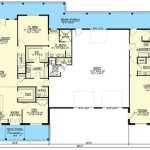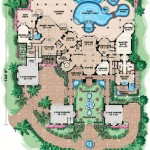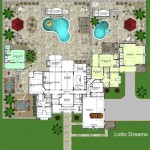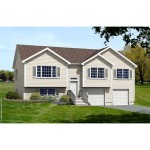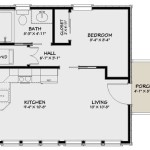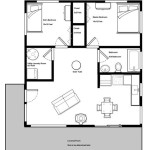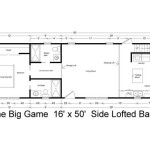5 Bedroom House Floor Plan Ideas: Maximizing Space and Functionality
Designing a 5-bedroom house floor plan presents a unique set of opportunities and challenges. The primary goal is to create a comfortable and functional living space for a large family or a household with frequent guests. Thoughtful planning is crucial to ensure optimal use of space, privacy for occupants, and a cohesive flow throughout the home. This article explores several 5-bedroom floor plan ideas, focusing on key considerations for effective design and practical implementation.
The number of bedrooms inherently dictates the overall size and layout of the house. Factors like lot size, budget, and lifestyle preferences will significantly influence the final design. A two-story layout is often the most practical solution for accommodating five bedrooms, as it effectively utilizes vertical space, minimizing the footprint on the property. However, single-story designs are also possible, particularly on larger lots. Accessibility considerations might also favor a one-story design, especially if occupants have mobility limitations.
Before diving into specific floor plan ideas, it's important to understand the fundamental principles of good design. These include considering the orientation of the house to maximize natural light and ventilation, creating distinct zones for different activities (e.g., sleeping, living, working), and ensuring smooth and logical circulation patterns between rooms. Furthermore, attention to detail regarding storage solutions, bathroom placement, and kitchen design is essential for creating a livable and enjoyable home.
Prioritizing Privacy and Separate Zones
One of the most important aspects of a 5-bedroom floor plan is ensuring adequate privacy for each occupant. This is particularly crucial when designing for families with teenagers or providing guest accommodations. A common approach is to create distinct zones within the house. For instance, the master suite can be positioned away from the other bedrooms, perhaps on one side of the house or on a separate floor, to offer a more secluded retreat. Additional bedrooms can be grouped together, but careful consideration should be given to soundproofing and layout to minimize disturbances.
A well-defined guest suite is another valuable feature in a 5-bedroom house. This suite might include a private bathroom and possibly a small living area, providing guests with a comfortable and independent space. Locating the guest suite near the main entrance can also enhance convenience and privacy. This can be achieved by designating a bedroom on the main floor as a guest room, with easy access to a powder room or a full bathroom.
In two-story designs, the upper level is typically reserved for bedrooms, while the ground floor houses the main living areas, kitchen, and dining room. This separation naturally contributes to privacy. However, it's important to ensure that the staircase is conveniently located and well-lit. The placement of bedrooms on the second floor can also benefit from strategic layout. For example, children’s rooms might be clustered around a shared bathroom and play area, while the master suite occupies a more secluded corner.
Another approach to enhance privacy is by incorporating features like walk-in closets and ensuite bathrooms for each bedroom. While this may increase the overall cost of the project, it significantly improves the comfort and convenience of the occupants. Thoughtful placement of windows and doors can also contribute to privacy, preventing direct views into bedrooms from adjacent rooms or outside the house.
Optimizing Common Areas and Functionality
While bedrooms provide individual spaces, the common areas of a 5-bedroom house play a vital role in fostering family interaction and creating a sense of community. The design of these areas should prioritize functionality, comfort, and a sense of openness. The kitchen, living room, and dining room are typically the focal points of these areas, and their layout should encourage seamless flow and interaction.
An open-concept layout, where the kitchen, living room, and dining room are combined into one large space, is a popular choice for modern homes. This layout promotes a sense of spaciousness and allows for easy communication between family members. However, it's important to define distinct zones within the open space to prevent it from feeling chaotic. This can be achieved through the strategic use of furniture, rugs, and changes in flooring material.
The kitchen should be designed with both functionality and aesthetics in mind. Ample counter space, storage, and adequate lighting are essential. A kitchen island can serve as a central hub for food preparation, dining, and social interaction. Consider incorporating features like a walk-in pantry or a butler's pantry to maximize storage space and minimize clutter. The placement of appliances, such as the refrigerator, oven, and dishwasher, should be carefully considered to create an efficient work triangle.
The living room should be designed as a comfortable and inviting space for relaxation and entertainment. A fireplace can serve as a focal point, creating a warm and cozy atmosphere. Ample seating should be provided to accommodate the entire household. Consider incorporating built-in shelving or a entertainment center to provide storage for books, media equipment, and other items. Natural light is crucial in the living room, so maximize the size and number of windows.
The dining room should be located adjacent to the kitchen for easy serving and cleanup. The size of the dining table should be appropriate for the number of occupants. Consider incorporating features like a buffet or a sideboard to provide additional storage for dinnerware and serving dishes. Adequate lighting is essential in the dining room, so consider installing a chandelier or pendant lights above the dining table.
In addition to the main living areas, consider incorporating other common spaces, such as a home office, a playroom, or a media room. These spaces can provide additional functionality and cater to the specific needs of the household. A home office is particularly important in today's world, where many people work remotely. A playroom can provide a safe and stimulating environment for children to play and learn. A media room can provide a dedicated space for watching movies and playing video games.
Maximizing Space Utilization and Storage Solutions
Effective space utilization and ample storage are crucial for maintaining a clutter-free and organized home, especially in a 5-bedroom house. Every square foot should be thoughtfully considered, and storage solutions should be integrated into the design from the outset. This encompasses not only closets and cabinets but also creative solutions like built-in shelving, under-stair storage, and multi-functional furniture.
Closet space is a primary consideration in any bedroom. Walk-in closets are ideal for providing ample storage for clothing, shoes, and accessories. However, if space is limited, reach-in closets with well-organized shelving and hanging rods can also be effective. Consider incorporating features like adjustable shelves, drawers, and shoe racks to maximize storage capacity. Mirror doors can also help to make the closet feel larger and brighter.
Beyond closets, built-in shelving can provide additional storage in bedrooms, living rooms, and other areas of the house. Built-in shelves can be used to display books, artwork, and other decorative items. They can also be used to store frequently used items, such as toys, games, and office supplies. Built-in shelves can be customized to fit the specific needs of the household.
Under-stair storage is a often overlooked area that can be effectively utilized. This space can be transformed into a closet, a pantry, a home office, or even a small playroom. Custom-built cabinets and drawers can be designed to maximize the storage capacity of this space. Consider incorporating features like pull-out shelves, drawers, and organizers to make the storage more accessible and efficient.
Multi-functional furniture is another great way to maximize space in a small home. For example, a sofa bed can provide additional sleeping space for guests. A coffee table with storage can provide a place to store blankets, pillows, and other items. A dining table with leaves can be expanded to accommodate larger gatherings. Multi-functional furniture can be both stylish and practical, and it can help to make the most of a limited space.
Vertical space is often underutilized in homes. Consider incorporating features like high ceilings and loft spaces to add visual interest and create additional storage opportunities. High ceilings can make a room feel larger and more open. Loft spaces can be used as bedrooms, home offices, or playrooms. Vertical storage solutions, such as tall cabinets and shelves, can also help to maximize space utilization.
Finally, it's important to declutter regularly and get rid of items that are no longer needed. This will help to keep the house organized and free from clutter. Consider donating unwanted items to charity or selling them online. A clutter-free home is a more comfortable and enjoyable place to live.

230 Best 5 Bedroom House Plans Ideas Dream Floor

490 5 Bedroom House Plans Ideas In 2024

Mediterranean Style House Plan 5 Beds 3 Baths 4457 Sq Ft 320 1469 Plans One Story Bedroom 6

5 Bedroom House Plans Monster

5 Bedroom House Plan Examples

Room To Grow 5 Bedroom House Plans Houseplans Blog Com

5 Bedroom Apartment Plan Examples

5 Bedroom House Plans Floor

Gorgeous 17 Best Ideas About 5 Bedroom House On Plans 4

5 Bedroom House Plan Examples

